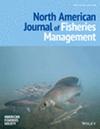评估可见植入弹性体(VIE)标签在补充濒危河口鱼类中的应用
IF 1.4
4区 农林科学
Q3 FISHERIES
引用次数: 0
摘要
目标三角洲胡瓜鱼(Hypomesus transpacificus)被认为在野外濒临灭绝,这促使多机构开展保护工作,以补充其种群数量。在近期开展这些工作的同时,还需要进行监测,以评估补充的效果。方法在这项研究中,我们评估了可见植入弹性标签在三角洲胡瓜鱼中的使用情况,以确定鱼类存活率、鱼类生长或标签保留是否取决于(1)标签颜色(蓝色、绿色、橙色、红色、黄色和无标签对照)或(2)标签身体位置(后背、前背、中侧线和无标签对照)。结果在第一次实验的 165 天内,不同颜色的标签在生长速度(平均 = 0.073 mm/d,范围 = 0.072-0.075 mm/d)和存活率(平均 = 68%,范围 = 63-77%)方面没有差异。在所有颜色组中,平均标签保留率为 96%(范围 = 87-100%)。在第二次实验的 120 天内,标签位置对鱼的生长速度(平均 = 0.064 mm/d,范围 = 0.062-0.067 mm/d)或存活率(平均 = 50%,范围 = 43-58%)没有影响。结论我们的结果表明,可见植入弹性体标签是标记成年三角洲胡瓜鱼(叉长 50 毫米)长达 165 天的合适方法,可用于保护监测工作。本文章由计算机程序翻译,如有差异,请以英文原文为准。
Evaluation of visible implant elastomer (VIE) tags for use in supplementation of an endangered estuarine fish
ObjectiveDelta Smelt Hypomesus transpacificus are thought to be close to extinction in the wild, which has spurred multiagency conservation efforts to supplement their population. In conjunction with these recent efforts, monitoring is needed to assess the effectiveness of supplementation. Such monitoring often uses large‐scale tagging of released fish to distinguish between hatchery‐origin and wild‐origin fish that are captured during later surveys.MethodsIn this study, we evaluated the use of visible implant elastomer tags in Delta Smelt to determine whether fish survival, fish growth, or tag retention were dependent on (1) tag color (blue, green, orange, red, yellow, and no‐tag control) or (2) tagged body location (posterior‐dorsal, anterior‐dorsal, mid‐lateral line, and no‐tag control).ResultOver 165 days of the first experiment, there was no difference in growth rate (mean = 0.073 mm/d, range = 0.072–0.075 mm/d) or survival (mean = 68%, range = 63–77%) among tag colors. Across all color groups, mean tag retention was 96% (range = 87–100%). Over 120 days of the second experiment, tag location had no influence on fish growth rate (mean = 0.064 mm/d, range = 0.062–0.067 mm/d) or survival (mean = 50%, range = 43–58%). For the surviving fish in experiment 2, the tags that were placed at the mid‐lateral line were retained less (84% on day 120) than those at posterior‐dorsal and anterior‐dorsal locations (99% and 98%, respectively).ConclusionOur results suggest that visible implant elastomer tagging is a suitable method for marking adult Delta Smelt (>50 mm fork length) for up to 165 days and can be useful for conservation monitoring efforts.
求助全文
通过发布文献求助,成功后即可免费获取论文全文。
去求助
来源期刊
CiteScore
2.60
自引率
18.20%
发文量
118
审稿时长
2 months
期刊介绍:
The North American Journal of Fisheries Management promotes communication among fishery managers with an emphasis on North America, and addresses the maintenance, enhancement, and allocation of fisheries resources. It chronicles the development of practical monitoring and management programs for finfish and exploitable shellfish in marine and freshwater environments.
Contributions relate to the management of fish populations, habitats, and users to protect and enhance fish and fishery resources for societal benefits. Case histories of successes, failures, and effects of fisheries programs help convey practical management experience to others.

 求助内容:
求助内容: 应助结果提醒方式:
应助结果提醒方式:


